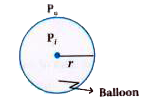A hot air balloon is a sphere of radius 8m . The air inside is at a temperature of 60∘C. How large a mass can the balloon lift when the outside temperature is 20∘C ? Assume air is an ideal gas , R =8.314J mole−1k−1,1 atm
=1.013×105Pa , the membrane tension is
=5N/m.Solution in Gujrati
The pressure inside the balloon be PiandPi>Po.

Excess pressure Pi−Po=2sr
where s= surface tension ,r =radius of balloon
Considering the air to be ideal gas ,
PiV=niRTi ...(1)
Where V= is the volume of the air inside the balloon)
ni = the number of moles of inside air
Ti= the temperature of inside air
For air outside the balloon,
PoV=noRTo ....(2)
where V= volume of the air displaced
Po= air pressure outside
no = number of moles of air displaced
To= outside temperature
From equation (1),
ni=PiVRTi=MiMA .....(3)
where Mi mass of air inside and MA is the molar mass of air .)
From equation (2),
no=PoVRTo=MoMA ....(4)
(Where Mo= mass of air outside that has been displaced.)
If W is the load it can raise , then
W+Mig=Mog
W=Mog−Mig ...(5) 
There is 21%O2and79%N2 in air .
∴ Molar mass of air =(0.21×32)+(0.79×28)
=28.84g
Weight carried by balloon ,
W=(Mo−Mi)g
From equation (3),(4) putting value of MoMi in above equation,
W=(MAVRPoTo−MAVRPiTi)g
W=MAVR[PoTo−PiTi]−g
(Volume of balloon V=43πr3)
W=0.02884×43π×83×9.88.314
[1.013×105293−1.013×105333]
W=0.0884×43π×838.314×(1.013×105)
[1293−1333]×9.8
W=3044.2N
∴mg=3044.2
∴m=Wg=3044.210=304.42kg
m=305kg
Topper's Solved these Questions
- BOOK - KUMAR PRAKASHANCHAPTER - MECHANICAL PROPERTIES OF FLUIDS EXERCISE - SECTION - E (MCQS)27videos
MECHANICAL PROPERTIES OF FLUIDS
- BOOK - KUMAR PRAKASHANCHAPTER - MECHANICAL PROPERTIES OF FLUIDS EXERCISE - SECTION - F (Questions from Module)21videos
MECHANICAL PROPERTIES OF FLUIDS
- BOOK - KUMAR PRAKASHANCHAPTER - MECHANICAL PROPERTIES OF FLUIDS EXERCISE - SECTION - (D NCERT Exemplar Solution) (Short Answer Type Questions5videos
MECHANICAL PROPERTIES OF FLUIDS
- BOOK - KUMAR PRAKASHANCHAPTER - MACHANICAL PROPERTIES OF SOLIDS EXERCISE - QUESTION PAPER11videos
MACHANICAL PROPERTIES OF SOLIDS
- BOOK - KUMAR PRAKASHANCHAPTER - MOTION IN A STRAIGHT LINE EXERCISE - QUESTION PAPER11videos
MOTION IN A STRAIGHT LINE
Similar Questions
Velocity of water in a river is …….
02:04View SolutionBernoulli's equation is based on conservation of …..
07:12View SolutionThe sap in trees , which consists mainly of water in summer , rises in a system of capillaries of radius r=2.5×10−5m .The surface tension of sap is T=7.28×10−2Nm−1 and the angle of contact is 0∘ .Does surface tension alone account for the supply of water to the top of all trees ?
03:36View SolutionWhat is called brittle material ?
View SolutionDefine frame of reference and give its types.
View SolutionThe heated air inside a hot air balloon weighs 5000 N. If the balloon supports a weight of 2000 N, what is the wieght of air displaced by the balloon?
03:46View SolutionA hot air balloon is a sphere of radius 8 m . The air inside is at a temperature of 60∘C. How large a mass can the balloon lift when the outside temperature is 20∘C? (Assume air is an ideal gas R=8.314Jmole−1K−1,1atm.=1.013×105Pa , the membrane tension is 5Nm−1)
01:14View SolutionA balloon containing 1 mole air at 1 atm initially is filled further with air till pressure increases to 4 atm. The intial diameter of the ballon is 1 m and the pressure at each stage is proportional to diameter of the balloon. How many moles of air added to change the pressure from 1 atm to 4 atm.
06:31View SolutionWhat will be the temperature difference needed in a hot air balloon to lift 1.0 kg of mass?Assume that the volume of balloon is 100m3, the temperature of ambient air is 25∘C , the pressure is 1 bar, and air is an idela gas with an average molar mass of 29 g mol−1 ( hot and cold both )
03:17View SolutionA balloon containing 1 mole air at 1 atm initially is filled further with air till pressure increases to 3 atm. The intial diameter of the balloon is 1 m and the pressure at each state is proportion to diameter of the balloon. Calculate ( a) No. of moles of air added to change the pressure from 1 atm to 3 atm. ( b) balloon will burst if either pressure increases to 7 atm or volume increases to 36 pi m^(3) .Calculate the number of moles of air that must be added after initial condition to burst the balloon.
03:12View SolutionTwo mole of ideal helium gas is in a rubber balloon at 30∘C. The balloon is fully expandable and an be assumed to required no energy in its expansion. The temperature of the gas balloon is slowly charged to 35∘C. Taking R=8.31J.mol−1.K−1 calculate the amount of heat required to raise that temperature.
09:11View SolutionA: Hot air balloon rises up by displacing the denser air of the atmosphere. R: The given mass of a gas becomes less denser.
08:12View SolutionPay load is defined as the difference between the mass of displaced air and the mass of the balloon. Calculate the pay load when a balloon of radius 10 m, mass 100 kg is filled with helium at 1.66 bar at 27∘C. (Density of air= 1.2 kg m−3 and R=0.083 bar dm3K−1mol−1)
06:38View SolutionAn empty balloon weighs W1. If air equal in weight to W is pumped into the balloon, the weight of the balloon becomes W2. Suppose that the density of air inside and outside the balloon is the same. Then
02:05View SolutionA balloon containing 1 mole air at 1 atm initially is filled further with air till pressure increases to 4 atm. The intial diameter of the ballon is 1 m and the pressure at each stage is proportional to diameter of the balloon. How many moles of air added to change the pressure from 1 atm to 4 atm.
04:25View Solution

